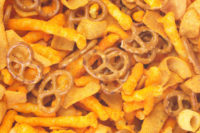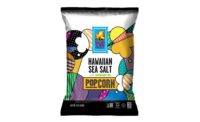
Snacks And Packaging
‘The Sky is the Limit’ for Flexible Packaging Innovation
When asked what the biggest changes in flexible packaging for snacks over the last three years were, four executives from leading film or packaging manufacturers included improved graphics in their answers.
“From my perspective, the single biggest improvement over the last three years is the improved quality of flexography printing to recreate product illustrations and photography,” said Lee Peterson of Bryce, Inc., Memphis, Tenn.
Snack manufacturers taking advantage of these improved graphics will have an advantage in the marketplace, since many consumers make snack purchases based on their first impressions. Bright colors and visually appealing, realistic product graphics must catch the eye of the consumer who usually makes a decision to purchase within seconds, points out Ken Smith, Operations Planning Manager for Printpack Inc., Atlanta.
“Packaging is critical to the success of the snack food item since it must create immediate attention, showcase the product and elicit action from the consumer at the store level,” stressed Rick Sullivan, vice president of sales for C-P Packaging, York, Pa.
Selecting Colors
The colors on a food package play a major role in branding by grabbing the attention of the customer. Color will draw the focus of a customer from a greater distance than the actual graphics will, notes Tony Sebben, director of product development for Plastic Packaging Technologies, LLC, Kansas City, Kan.
Colors also play an important role in identifying snack flavors. For example, a yellow background color is often used for regular potato chips, orange or red backgrounds for barbecue potato chips and green for sour cream and onion.
A brand’s color influences our perception of a product, not the product inside, points out Peterson. As examples, he explains that while Coke owns red and Pepsi owns blue, their products are brown, and Tide owns Orange, but its product is white with cyan dots. Rarely do we think of brown, which UPS owns, when reaching for a soft drink in a can.
“I believe color is the single most import element to a brand’s identity on your packaging,” he stresses.
Color creates emotions: Reds are fiery, hot and stimulating, while blues can be like water, calming and peaceful, continues Peterson. Color also evokes taste and smell. Green vegetable packaging looks fresher, orange orange juice looks better tasting and better for you, and light blue water looks cooler. Package designers use color on packaging to evoke these perceptions about the product within the package.
Structural Advances
The last few years also have brought about the necessity to provide improved structural attributes in a competitive market and at a reasonable price, Smith says. As the snack market has become more and more competitive, so has the flexible packaging market that serves those producers, he explains.
“While keeping costs low, the snack producers still want improved barriers, improved seal strengths to allow for increased speeds on the new vertical form-and-fill equipment, wider seal ranges with lower coefficient of friction that are more forgiving on the newer packaging equipment, white metallized films, which hide the oils on the inside of the bag, and higher quality graphics than ever before,” he adds.
New film technologies have created higher-performance, higher-barrier films which can extend shelf life, keeping products fresher longer, explains Sullivan. Some of these new films will allow for the production of 2-ply film structures to replace existing 3-ply structures without sacrificing barrier properties, thereby creating economic benefits for the snack producers.
Film technology also is evolving to improve the oxygen transmission rates as well as improving the water vapor transmission rate, says Sebben. With the use of adhesive and extrusion laminations, structures for packages can be developed for the specific product that is going to be packaged.
“With the films that are available today, a snack food company can develop a variety of structures that will best serve their product’s particular demands,” he explains.
Better Machineability
Another area where film technology has made a difference is in improved machineability of packages. Improved slip packages and sealant layers have helped the package to be able to be formed and filled faster and more efficiently, Sebben explains. This improved technology has increased packaging machine running speeds and have lowered packaging waste.
The ability to produce thinner films also has reduced waste, making them more environmentally friendly and offering an economic advantage, adds Jim Rich, vice president, sales and marketing, AET Films. Not only have thinner films been developed, these films also have better puncture resistance, he adds.
In snack manufacturing, time is money, and the faster a package can be formed and filled, the better. With some products, the limiting factor has become how quickly the product can be dropped through the former and into the package, Smith says. To do this, he explains, the packaging material must have the coefficient of friction (COF) necessary to slide easily while still maintaining strong seals. This can be difficult with the new, thicker sealants that utilize very soft resins that tend to have high COF. At the same time, hot tack is necessary for the sealant to set up quickly enough to hold heavy products in time to be cut prior to the next cycle on the machine. Products that used to roll off the form/fill/seal machines at 40 or 50 bags per minute are now being formed and filled in excess of 130 bags per minute.
The Future
When asked about the future innovations for flexible packaging, Peterson says, the sky is the limit. He suggests looking at how packaging has changed the last few years and to see what advances are on the horizon for the future, such as package design becoming more sophisticated and consumer marketing becoming more targeted. And, he says, printing will become more customized, with perhaps the same product packaged differently for different target consumer markets. Changes in packaging materials and advances in delivery systems will be dictated by consumers’ preferences.
More specifically, the use of full-body shrink sleeves on large-format containers and jugs will significantly enhance the shelf impact of these packages, allowing for 360-degree graphics on the entire container — sharp contrast to the small labels on most containers today, says Sullivan. This will lead to enhanced shelf presence and brand recognition opportunities, he adds.
In addition, consumers’ continued search for convenience will lead to more easy-to-open packaging, individual portions, ready-to-eat packages, and reclosable packages, says Sebben. Snack food packaging will continue to evolve to meet the demands of the marketplace. Packaging machines will get faster, distribution demands will get tougher and products will change shape, weight and form, Smith adds.
The ongoing trend for flexible snack packages is “getting more for less without losing the integrity that the consumer demands,” explains Smith. “Cost is important, and we are continually finding better print surfaces, stronger sealant materials and higher-barrier resins while considering the effects that the products and packaging machines can have on the package.”




